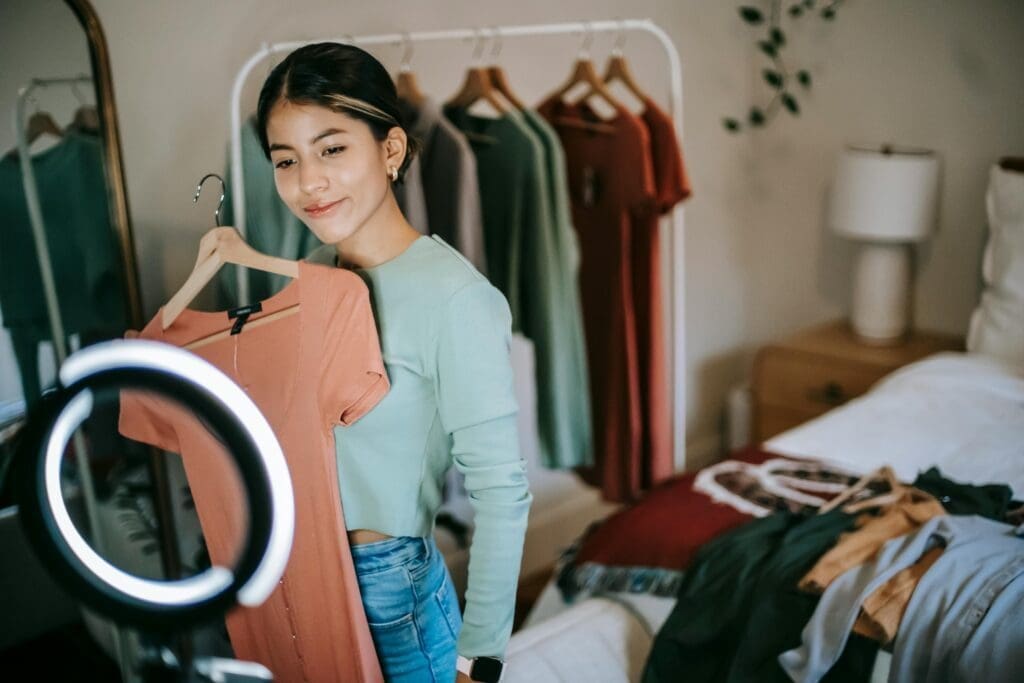You hit “publish,” and for a moment, the view count jumps. Another try-on haul delivered its usual burst of temporary excitement. But hours later, the algorithm moves on, your audience forgets, and you’re left wondering how long you can keep buying new pieces just to stay visible. If this cycle feels familiar, here’s the truth: fashion tips that create impact, community, and real engagement don’t require a constant rotation of new products.
This guide breaks down how fashion bloggers and creators can grow ethically, without overspending, endless unboxing, or performative sustainability. Just smart, conscious fashion content that teaches, inspires, and earns trust.
The Shift: Why Hauls No Longer Hold Power

For years, hauls dominated fashion content but the cultural tide is shifting. Viewers aren’t impressed by mountains of new clothing anymore. As conversations about fast fashion become mainstream, people are questioning the real cost behind constant purchasing.
A 2022 Project Cece report by Giada Nizzoli points out the core issue: haul videos normalize treating clothing as disposable. The impact is massive. Fast fashion generates 92 million tonnes of waste annually, and most returned items aren’t even resold doubling their carbon footprint. Donation isn’t a solution either, since only 20% of donated garments actually make it to resale.
This is why audiences are changing their expectations:
- Flashy buying sprees now feel disconnected from reality. Viewers are increasingly aware of the environmental and ethical consequences behind every “mini haul.”
- Creators who re-wear and re-style feel more credible. Consistency and intentionality signal authenticity in a way endless unboxings can’t.
- Creativity is more inspiring than consumption. As Nizzoli explains, haul culture often replaces genuine styling with shopping. Today, audiences reward creators who can make old pieces feel new.
This shift isn’t a limitation it’s an opportunity. When you’re no longer performing consumption, you have more space to showcase real skill, personal taste, and thoughtful fashion storytelling.
Understanding What Your Readers Want Now

Your audience isn’t just scrolling for “cute outfits.” They want clarity, guidance, and authenticity, especially when it comes to sustainability. A recent study by Bazaarvoice’s Influenster community highlights that 30% of consumers believe brands are not fully transparent when using terms like “eco-friendly” or “sustainable,” while 24% feel such claims are used mainly to drive sales.
Here’s what this means for fashion bloggers and content creators:
- Actionable Fashion Tips That Apply to Their Closet. Consumers are actively searching for practical advice on using sustainable or conscious pieces. They want tips they can actually apply to their existing wardrobes rather than being sold endless new items.
- Relatable Stories About Style Evolution and Mindful Habits. The study found that 88% of consumers believe brands have a responsibility to protect both people and the planet. Sharing your personal journey with ethical fashion, like outfit remixing, repairing, or curating a conscious wardrobe, resonates deeply.
- Transparency About Your Wardrobe, Spending, and Partnerships. With 60% of consumers actively looking at blogs, social media, and websites to understand sustainability efforts, transparency is key. Sharing your decision-making process, budget-conscious tips, or ethical brand criteria builds trust.
- Ideas Rooted in Conscious Fashion, Not Constant Consumption. Audiences are seeking authentic guidance on eco-conscious practices. They reward creators who demonstrate intention over impulse, showing that style doesn’t need to come at the expense of ethics.
Because when readers feel informed, respected, and included, they don’t just stay, they engage, share, and return. Transparency and authenticity are no longer optional; they’re the new currency of influence.
Reposition Yourself as a Style Guide, Not a Shopper

Your influence doesn’t come from how many new pieces you buy it grows when you teach. Velasco-Molpeceres’ research highlights that slow-fashion communication thrives when creators focus on education, storytelling, and transparency instead of product pushing. In other words, people follow you for your mind, not your hauls.
When you shift toward skill-based content, every part of your output becomes more valuable. Captions start teaching, visuals become demonstrations, and your personal reflections guide your audience toward better, more intentional fashion choices. This not only elevates your content it strengthens your credibility.
Here’s how this approach looks in practice:
- Show How You Build Outfits From Pieces You Already Own. Create styling formulas like “one base + one layer + one texture” or “neutrals + one statement color.” Demonstrate remixing the same pieces in multiple ways.
- Explain Why Certain Silhouettes Work for Certain Body Types. For example: “If you’re wearing wide-leg trousers, try a fitted top to highlight your waist,” or “Boxy jackets pair best with slimmer bottoms to avoid visual bulk.”
- Break Down Color Theory With Simple, Visual Examples. Show how complementary colors work like navy with mustard, or sage with rust. Teach viewers how to build color clusters that make their wardrobe feel more cohesive.
- Compare Fabrics, Cuts, and Tailoring Techniques in Detail. Explain why a structured cotton poplin shirt drapes differently than a fluid Tencel one, or how a well-placed dart can completely change the fit of a dress. These details help your audience understand quality on sight.
Velasco-Molpeceres found that slow-fashion brands using educational and ethical messaging not high-volume posting or hype-driven promos build deeper, more lasting audience trust. When you position yourself as a style guide, your content stops being “just another outfit post” and becomes something more: a resource your followers save, return to, and rely on.
Shop-Your-Closet Content That Actually Performs
Unlock the potential of the wardrobe you already own. Instead of constantly buying new pieces, focus on creativity, versatility, and thoughtful styling. A recent MDPI study by Ellen Lee and Franzisca Weder highlights how social media content around slow fashion, like making the most of existing clothing, can influence sustainable consumption practices and inspire audiences to rethink their fashion choices.
Style Challenges With Realistic Outcomes
Create weekly or monthly challenges using a single item styled in multiple ways. For example:
- One blazer → workwear, weekend, travel, night out
- One pair of denim → polished, casual, elevated basics
These challenges resonate because they showcase imagination over excess, aligning with the principles of slow fashion, where conscious consumption and creativity are valued over fast, disposable trends.
Seasonal Capsule Wardrobes
Capsules remain one of the most search-friendly and shareable conscious fashion formats. Break down:
- Why each item earned a spot
- How fabrics and cuts affect versatility
- What to swap based on climate or lifestyle
The structure offers clarity, and clarity drives clicks while encouraging audiences to embrace long-lasting, versatile pieces rather than continually buying new items.
Repair, Alter, and Remix Stories
Audiences love seeing your thought process. Share:
- How do you revive older pieces
- Tailor recommendations and price ranges
- Before-and-after transformations
This sets you apart from creators whose only “solution” is buying something new, reflecting slow fashion’s focus on sustainable practices, mindful consumption, and community-centered storytelling.
Content Formats That Replace Hauls (And Perform Better)

Your readers want guidance, not pressure, and research shows that the type of content you share makes a big difference. A 2025 study by El-Shihy & Awaad in Future Business Journal examined how brand-generated content (BGC) and user-generated content (UGC) on TikTok and Instagram influence Gen Z’s purchase intentions for sustainable fashion.
The study found that BGC, with its professional quality and emotional appeal, and UGC, with its authenticity and relatability, both positively affect purchase behavior, especially when paired with strong social media engagement (likes, shares, and comments).
This supports the shift away from repetitive “haul” videos toward content that educates, inspires, and provides practical guidance. Here are some formats that align with this approach:
- Closet Repeats With Context – Show the same item styled in multiple ways to illustrate versatility and creativity.
- Weekly Problem-Solving Posts – Address real-life style challenges, e.g., “How do I dress for heat without looking sloppy?”
- Deep-Dive Style Tutorials – Teach fit rules, layering tricks, and accessorizing strategies.
- Ethical Brand Spotlights – Highlight what makes a brand ethical or sustainable, rather than simply promoting products.
- Personal Style Journals – Share your wardrobe decisions and reflections to inspire mindful fashion choices.
Because these formats emphasize authenticity, engagement, and practicality, they are more likely to foster loyal followers and drive sustainable purchasing behaviors, aligning perfectly with Gen Z’s values.
Monetizing Without Compromising Your Values

You can absolutely earn from your influence without feeding into fast-fashion cycles. The key is choosing income streams that support mindful consumption not constant buying.
Curated Affiliate Edits
Swap “20 links” for five intentional picks. Explain why each piece is worth investing in, what quality markers to look for, and how to style it multiple ways. This builds trust instead of pressure.
Digital Products That Teach, Not Push Consumption
Create resources that help your audience use what they already own, such as:
- Capsule wardrobe planners
- Fit + tailoring guides
- Color palette worksheets
- Seasonal lookbook templates
These generate recurring income while supporting sustainable habits not impulse hauls.
Value-Based Styling Services
Offer services that help followers build intentional wardrobes:
- Virtual closet audits
- Personalized style guides
- Ethical styling sessions
These turn your expertise into impact and income.
Ethical Brand Partnerships
Partner only with brands that match your values. Ask:
- Are their materials traceable and ethical?
- Do they disclose supply-chain details?
- Do they offer repairs, recycling, or take-back programs?
Research in Frontiers in Communication (2025) shows that influencer credibility especially around expertise and ethical alignment significantly shapes Gen Z’s trust, attitudes, and purchasing behavior.
Boosting Engagement Without Relying on Newness

In sustainable fashion content, engagement doesn’t come from showing constant newness it comes from creating conversations that make your audience feel involved and informed. Research from Cogitatio shows that content tied to social responsibility sparks higher engagement on Instagram, increasing reactions and strengthening brand reputation.
Here are community-driven formats that encourage interaction without pushing consumption:
- Polls & Style Dilemmas: Ask questions like “Which piece should I restyle next?” to invite your audience into the creative process.
- Ask‑Me‑Anything Threads: Host Q&As around conscious fashion, outfit repeating, repair tips, or mindful styling habits.
- Open Closet Tours: Walk followers through your wardrobe philosophy why you keep certain pieces, how you repair items, and what makes a garment worth owning.
- Duet / React to Follower Outfits: Spotlight your audience by reacting to their fits, offering styling suggestions, or remixing their looks.
By shifting focus from “here’s something new” to “here’s something meaningful,” you build engagement rooted in learning, collaboration, and shared values not constant consumption.
SEO That Helps Your Blog Grow Long-Term

To make your conscious fashion content discoverable, optimize with intention. A strong SEO strategy not only drives traffic but also reinforces your brand values and helps you reach the right audience.
Use keywords naturally. Weave terms like “fashion tips” and “ethical fashion” into your intro, subheadings, and conclusion. Avoid stuffing context matters more than raw frequency.
Cluster related keywords. Group terms into semantic sets. For example:
- Capsule closet: sustainable wardrobe, versatile outfits, minimalism
- Conscious fashion: ethical brands, slow fashion, mindful shopping
Structure your posts for clarity. Use headings (H2/H3), numbered lists, examples, short-form content, FAQs, and micro-guides. This improves scannability and satisfies micro-intents.
Optimize images. Use descriptive file names and ALT text, e.g., linen-fabric-close-up-showing-weave-texture.jpg. Visual search is increasingly important in 2025 for fashion brands.
Highlight trust signals. Share sourcing, certifications, or sustainable practices. Google’s E-E-A-T (Experience, Expertise, Authoritativeness, Trustworthiness) rewards transparent, credible brands.
By combining these modern SEO practices from keyword clusters to visual optimization and trust-building you make your content discoverable, credible, and valuable. SEO becomes a framework that amplifies your creativity, connecting the right audience to your fashion blog at the right time.
Why Ethical Fashion Tips for Blogging Is the Future

You don’t need endless shopping bags or constant hauls to run a successful fashion blog. Your audience wants guidance help making thoughtful choices, refining personal style, and understanding why certain pieces truly work.
- Creativity = value – Show unique styling, capsule wardrobes, and purposeful edits.
- Insight = hook – Share knowledge about materials, fit, and sustainability.
- Integrity = brand – Be transparent, ethical, and authentic.
Start with your first style remix today and see how intention-driven content builds trust and influence. By centering your blog on purpose and ethics, you move from content creator to trusted guide, proving that ethical fashion blogging isn’t just a trend it’s the future of style.
FAQs About Fashion Blogging Tips
1. How can I start a fashion blog without contributing to fast fashion?
Focus on content that teaches, repurposes, or highlights ethical brands. Share outfit repeats, capsule wardrobe ideas, styling tutorials, and repair or remix stories instead of unboxing new products constantly.
2. What are some ways to make my existing wardrobe more sustainable?
Encourage practices like upcycling, tailoring, swapping with friends, or creating seasonal capsule wardrobes. Highlighting these methods in your blog inspires readers to make mindful choices.
3. How can I engage my audience without relying on product promotions?
Interactive content works best: polls, style dilemmas, “Ask Me Anything” threads, open closet tours, and reacting to followers’ outfits foster community while keeping your content educational and entertaining.
4. Can ethical fashion blogging be profitable without fast fashion partnerships?
Yes. Monetization can come from curated affiliate edits with intentional pieces, digital products (capsule planners, lookbooks, styling guides), consultations, and partnerships with transparent, sustainable brands that align with your values.
5. How do I balance aesthetics and sustainability in my blog visuals?
High-quality photography, clean compositions, and versatile styling make your content visually appealing. At the same time, use your captions and image context to highlight conscious choices, fabric quality, or outfit versatility.





0 Comments